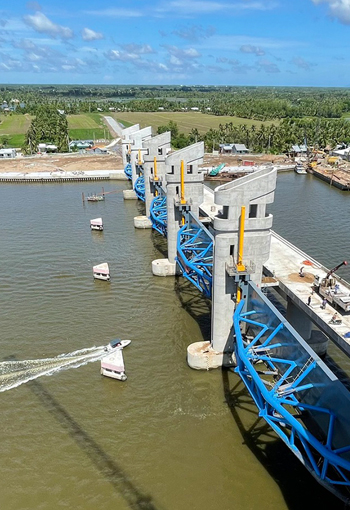Cai Lon - Cai Be Irrigation System project phase 1
Cai Lon - Cai Be Irrigation System project phase 1 (in the area of 2 districts An Bien and Chau Thanh, Kien Giang). The project has a total investment capital of more than VND 3,300 billion, invested by the Management Board of Irrigation Investment and Construction 10
The newly installed valve gate has an aperture of 40 m x 9 m and weighs 203 tons. Cai Lon sluice includes 11 valve gates; in which there are 8 valve gates with an aperture of 4 0m x 9 m, weighing 203 tons; 2 valves with aperture 40 m x 7.5 m, weighing 188 tons; 1 gate valve 40m x 6.0 m, weighs 155 tons.
Because of the huge size of the valve gates, the installation stage is very difficult and complicated when performing in the middle of the river, subject to the great pressure of the flow and blowing wind... Particularly for fixing equipment, lifting gate cranes, moving Moving the door to the culvert took 2-3 days to complete before it could be officially installed.
Normally a similar project takes at least 36 months, but due to the urgent need to prevent drought and salinity, the Investor and contractors tried to reduce it to 24 months. This is the largest irrigation project in Vietnam in terms of scale and aperture; was built on Cai Lon river, the work was manufactured, constructed and installed by LILAMA10 Joint Stock Company.

The valve gate system manufactured, constructed and installed by LILAMA10 Joint Stock Company.
According to the Ministry of Agriculture and Rural Development, once completed, the Cai Lon - Cai Be Irrigation System project will help control water sources and create stable and sustainable production conditions for production models for the benefit area. with a natural area of 384,120 ha, of which land for agricultural and fishery production is 346,241 ha. Besides, controlling water sources (salt, brackish, fresh), creating stable and sustainable production conditions for production models according to ecosystems (sweet, salty - brackish, fresh - brackish alternately). . In addition, the West Sea dyke is also combined to form a cluster of works that actively respond to climate change, sea level rise, natural disaster prevention and control, and reduce flooding when the ground is lowered (due to land subsidence); reducing damage caused by natural disasters (drought, salinity) in the dry season for production models in the region…


